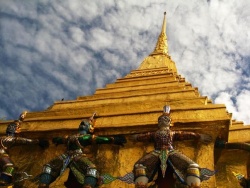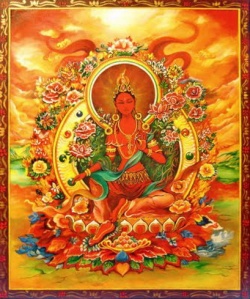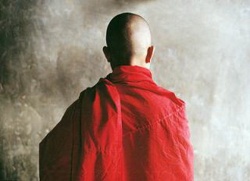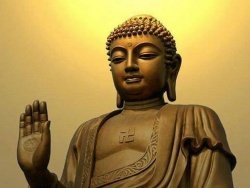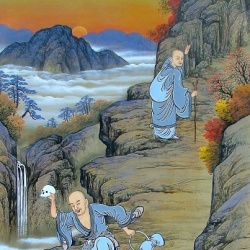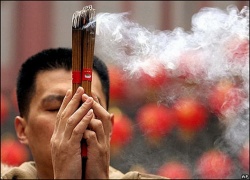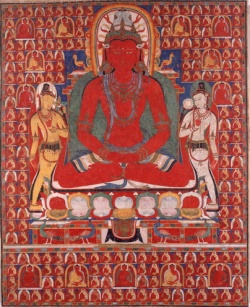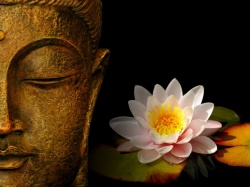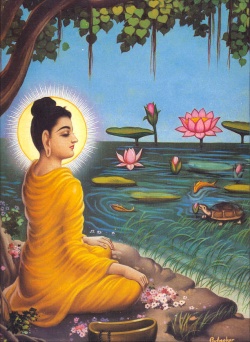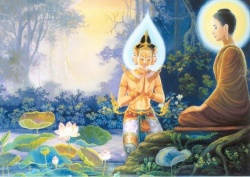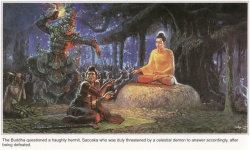Anguttara Nikaya
The Anguttara Nikaya (aṅguttaranikāya; literally "Increased by One Collection," also translated "Gradual Collection" or "Numerical Discourses") is a Buddhist scripture, the fourth of the five Nikayas, or collections, in the Sutta Pitaka, which is one of the "three baskets" that comprise the Pali Tipitaka of Theravada Buddhism. This Nikaya consists of several thousand discourses ascribed to The Buddha and his chief disciples arranged in eleven nipatas, or Books, according to the number of Dhamma items referenced in them.
The Anguttara Nikaya corresponds to the Ekottara Āgama ("Increased by One Discourses") found in the Sutra Pitikas of various Sanskrit'ic early Buddhists schools, fragments of which survive in Sanskrit. A complete version survives in Chinese translation by the name Zēngyī Ahánjīng (增一阿含經); it is Thought to be from either the Mahāsāṃghika or Sarvāstivādin recensions. According to Keown, "there is considerable disparity between the Pāli and the Sarvāstivādin versions, with more than two-thirds of the sūtras found in one but not the other compilation, which suggests that much of this portion of the Sūtra Piṭaka was not formed until a fairly late date.
The Anguttara Nikaya is the fourth book of the Sutta Pitaka, the first division of the Tipitaka, the sacred scriptures of Buddhism. The word anguttara means ‘up by one’ and is used because all the 2344 discourses or suttas in this book are arranged according to a numerical system from one to eleven. It has also been defined as "Numerical Discourses." The Anguttara Nikaya deals with a wider variety of subjects than any other division in the Tipitaka.
==Prominent teachings==
Since the Anguttara Nikaya deals with so many teachings, there are many significant teachings to found in this Nikaya or collection:
Anguttara Nikaya 4.21 The Buddha’s Refuge:
After enlightenment the Buddha said, “Let me then honor and respect and dwell in dependence on this very Dhamma to which I have fully awakened.”
Anguttara Nikaya 11.12 The Six qualities of the Dhamma:
1. Svakkhato: The Dhamma is not a speculative philosophy, but is the Universal Law found through enlightenment and is preached precisely. Therefore it is Excellent in the beginning (Sila — Moral principles), Excellent in the middle (Samadhi — Concentration) and Excellent in the end (Panna — Wisdom),
2. Samditthiko: The Dhamma is testable by practice and known by direct experience,
3. Akaliko: The Dhamma is able to bestow timeless and immediate results here and now, for which there is no need to wait until the future or next existence.
4. Ehipassiko: The Dhamma welcomes all beings to put it to the test and to experience it for themselves.
5. Opaneyiko: The Dhamma is capable of being entered upon and therefore it is worthy to be followed as a part of one's life.
6. Paccattam veditabbo vinnunhi: The Dhamma may be perfectly realized only by the noble disciples who have matured and enlightened enough in supreme wisdom.
Anguttara Nikaya 3.65 The Kalama Sutta, The Buddha’s Charter of Free Inquiry:
“Do not believe in something because it is reported. Do not believe in something because it has been practiced by generations or becomes a tradition or part of a culture. Do not believe in something because a scripture says it is so. Do not believe in something believing a god has inspired it. Do not believe in something a teacher tells you to. Do not believe in something because the authorities say it is so. Do not believe in hearsay, rumor, speculative opinion, public opinion, or mere acceptance to logic and inference alone. Help yourself, accept as completely true only that which is praised by the wise and which you test for yourself and know to be good for yourself and others.”
Anguttara Nikaya 3.65 Metta and the Brahma Viharas; loving kindness and the divine emotions:
“Now, Kalamas, one who is a disciple of the noble ones — thus devoid of greed, devoid of ill will, undeluded, alert, and resolute — keeps pervading the first direction [the east) — as well as the second direction, the third, and the fourth — with an awareness imbued with good will. Thus he keeps pervading above, below, and all around, everywhere and in every respect the all-encompassing cosmos with an awareness imbued with good will: abundant, expansive, immeasurable, free from hostility, free from ill will.
He keeps pervading the first direction — as well as the second direction, the third, and the fourth — with an awareness imbued with compassion. Thus he keeps pervading above, below, and all around, everywhere and in every respect the all-encompassing cosmos with an awareness imbued with compassion: abundant, expansive, immeasurable, free from hostility, free from ill will.
He keeps pervading the first direction — as well as the second direction, the third, and the fourth — with an awareness imbued with appreciation. Thus he keeps pervading above, below, and all around, everywhere and in every respect the all-encompassing cosmos with an awareness imbued with appreciation: abundant, expansive, immeasurable, free from hostility, free from ill will.
He keeps pervading the first direction — as well as the second direction, the third, and the fourth — with an awareness imbued with equanimity. Thus he keeps pervading above, below, and all around, everywhere and in every respect the all-encompassing cosmos with an awareness imbued with equanimity: abundant, expansive, immeasurable, free from hostility, free from ill will.”
The Christians have John 3:16, for Vegetarian Buddhists there is Anguttara Nikaya 3:16:
“Monks, one possessed of three qualities is put into Purgatory according to his actions. What three? One is himself a taker of life, encourages another to do the same and approves thereof.
Monks, one possessed of three qualities is put into heaven according to his actions. What three? He himself abstains from taking life, encourages another to so abstain, and approves of such abstention Anguttara Nikaya 3.16 . . . . (and speaks in praise of thereof . . .” added to this list in Anguttara Nikaya 10. 213)
Anguttara Nikaya 5.177 The five types of wrong livelihood:
“Monks, a lay follower should not engage in five types of business. Which five? Business in weapons, business in human beings, business in meat, business in intoxicants, and business in poison.”
Anguttara Nikaya 3.61 The Four Noble Truths:
Suffering, the cause of suffering, the way suffering ceases, and the Middle Path
Anguttara Nikaya 3.62 The Noble Eightfold Middle Path:
Right: Understanding, Thought, Speech, Action, Livelihood, Effort, Mindfulness, Concentration
Anguttara Nikaya 10.13 The ten hindrances to enlightenment:
The belief in a permanent personality /ego; Doubt, extreme scepticism; Clinging to rites, rituals, ceremonies; Attachment to sense desires; Ill-will / anger; Craving for form world; Craving for formless world; Conceit; Restlessness; Ignorance.
Anguttara Nikaya 4.241-243 Anyone from any religion can get to heaven:
“Another person has practiced the making of merit by giving as well as by moral discipline to a high degree; but he has not undertaken the making of merit by meditation. With the breakup of the body, after death, he will be reborn among humans in a favorable condition. Or he will be reborn in the company of the devas of the Four Great Kings.”
Anguttara Nikaya 2.25 The Dhamma is not a fundamentalist teaching:
“Monks, these two slander the Tathagata (Buddha). Which two? He who explains a discourse whose meaning needs to be inferred as one whose meaning has already been fully drawn out. And he who explains a discourse whose meaning has already been fully drawn out as one whose meaning needs to be inferred. These are two who slander the Tathagata.”
Translations
The Book of the Gradual Sayings, tr F. L. Woodward & E. M. Hare, 1932-6, 5 volumes, Pali Text Society, Bristol
A new translation by Bhikkhu Bodhi is forthcoming in September 2012 from Wisdom Publications Source to Order
Selections
1st 3 nipatas tr E. R. J. Gooneratne, Ceylon, c1913
4th nipata tr A. D. Jayasundare, London, 1925
anthology ed & tr Nyanaponika, Buddhist Publication Society, Kandy, Sri Lanka; revised, with additions & deletions, by Bodhi, as Numerical Discourses of The Buddha, Altamira Press, Oxford/New York/Lanham, Maryland/Walnut Creek, California, 1999
Divisions
The nipatas in this Nikaya are:
The Book of Ones
The Book of Twos
The Book of Threes
The Book of Fours
The Book of Fives
The Book of Sixes
The Book of Sevens
The Book of Eights
The Book of Nines
The Book of Tens
The Book of Elevens
Appreciation
Translator Bhikkhu Bodhi wrote: "In Anguttara Nikaya, persons are as a rule not reduced to mere collections of Aggregates, elements and sense-bases, but are treated as real centers of living experience engaged in a heartfelt quest for Happiness and freedom from Suffering."(from Intro to Samyutta Nikaya)
Buddhist texts
Digha Nikaya
Khuddaka Nikaya
Majjhima Nikaya
Samyutta Nikaya
The Anguttara Nikaya is the fourth book of the Sutta Pitaka, the first division of the Tipitaka, the sacred scriptures of Buddhism. The word anguttara means ‘up by one’ and is used because all the 2344 discourses or suttas in this book are arranged according to a numerical system from one to eleven. It has also been defined as "Numerical Discourses." The Anguttara Nikaya deals with a wider variety of subjects than any other division in the Tipitaka.
Prominent teachings
Since the Anguttara Nikaya deals with so many teachings, there are many significant teachings to found in this Nikaya or collection:
Anguttara Nikaya 4.21 The Buddha’s Refuge:
After Enlightenment The Buddha said, “Let me then honor and respect and dwell in dependence on this very Dhamma to which I have fully Awakened.”
Anguttara Nikaya 11.12 The Six qualities of the Dhamma:
1. Svakkhato: The Dhamma is not a speculative philosophy, but is the Universal Law found through Enlightenment and is preached precisely. Therefore it is Excellent in the beginning (Sila — Moral principles), Excellent in the middle (Samadhi — Concentration) and Excellent in the end (Panna — Wisdom),
2. Samditthiko: The Dhamma is testable by practice and known by direct experience,
3. Akaliko: The Dhamma is able to bestow timeless and immediate results here and now, for which there is no need to wait until the future or next existence.
4. Ehipassiko: The Dhamma welcomes all beings to put it to the test and to experience it for themselves.
5. Opaneyiko: The Dhamma is capable of being entered upon and therefore it is worthy to be followed as a part of one's Life.
6. Paccattam veditabbo vinnunhi: The Dhamma may be perfectly realized only by the Noble disciples who have matured and Enlightened enough in supreme Wisdom.
Anguttara Nikaya 3.65 The Kalama Sutta, The Buddha’s Charter of Free Inquiry:
“Do not believe in something because it is reported. Do not believe in something because it has been practiced by generations or becomes a tradition or part of a culture. Do not believe in something because a scripture says it is so. Do not believe in something believing a God has inspired it. Do not believe in something a teacher tells you to. Do not believe in something because the authorities say it is so. Do not believe in hearsay, rumor, speculative opinion, public opinion, or mere acceptance to logic and inference alone. Help yourself, accept as completely true only that which is praised by the wise and which you test for yourself and know to be good for yourself and others.”
Anguttara Nikaya 3.65 Metta and the Brahma Viharas; loving Kindness and the divine emotions:
“Now, Kalamas, one who is a Disciple of the Noble ones — thus devoid of Greed, devoid of ill will, undeluded, alert, and resolute — keeps pervading the first direction [the east) — as well as the second direction, the third, and the fourth — with an awareness imbued with good will. Thus he keeps pervading above, below, and all around, everywhere and in every respect the all-encompassing cosmos with an awareness imbued with good will: abundant, expansive, immeasurable, free from hostility, free from ill will.
He keeps pervading the first direction — as well as the second direction, the third, and the fourth — with an awareness imbued with Compassion. Thus he keeps pervading above, below, and all around, everywhere and in every respect the all-encompassing cosmos with an awareness imbued with Compassion: abundant, expansive, immeasurable, free from hostility, free from ill will.
He keeps pervading the first direction — as well as the second direction, the third, and the fourth — with an awareness imbued with Appreciation. Thus he keeps pervading above, below, and all around, everywhere and in every respect the all-encompassing cosmos with an awareness imbued with Appreciation: abundant, expansive, immeasurable, free from hostility, free from ill will.
He keeps pervading the first direction — as well as the second direction, the third, and the fourth — with an awareness imbued with Equanimity. Thus he keeps pervading above, below, and all around, everywhere and in every respect the all-encompassing cosmos with an awareness imbued with Equanimity: abundant, expansive, immeasurable, free from hostility, free from ill will.”
The Christians have John 3:16, for Vegetarian Buddhists there is Anguttara Nikaya 3:16:
“Monks, one possessed of three qualities is put into Purgatory according to his actions. What three? One is himself a taker of Life, encourages another to do the same and approves thereof. Monks, one possessed of three qualities is put into Heaven according to his actions. What three? He himself abstains from taking Life, encourages another to so abstain, and approves of such abstention Anguttara Nikaya 3.16 . . . . (and speaks in praise of thereof . . .” added to this list in Anguttara Nikaya 10. 213)
Anguttara Nikaya 5.177 The five types of wrong Livelihood:
“Monks, a lay follower should not engage in five types of business. Which five? Business in Weapons, business in human beings, business in meat, business in Intoxicants, and business in poison.”
Anguttara Nikaya 3.61 The Four Noble Truths:
Suffering, the cause of Suffering, the way Suffering ceases, and the Middle Path
Anguttara Nikaya 3.62 The Noble Eightfold Middle Path:
Right: Understanding, Thought, Speech, Action, Livelihood, Effort, Mindfulness, Concentration
Anguttara Nikaya 10.13 The ten hindrances to Enlightenment:
The belief in a permanent personality /ego; Doubt, extreme scepticism; Clinging to rites, rituals, ceremonies; Attachment to sense desires; Ill-will / Anger; Craving for Form World; Craving for formless World; Conceit; Restlessness; Ignorance.
Anguttara Nikaya 4.241-243 Anyone from any Religion can get to Heaven:
“Another person has practiced the making of Merit by giving as well as by Moral Discipline to a high degree; but he has not undertaken the making of Merit by Meditation. With the breakup of the Body, after Death, he will be reborn among humans in a favorable condition. Or he will be reborn in the company of the devas of the Four Great Kings.”
Anguttara Nikaya 2.25 The Dhamma is not a fundamentalist teaching:
“Monks, these two slander the Tathagata (Buddha). Which two? He who explains a discourse whose meaning needs to be inferred as one whose meaning has already been fully drawn out. And he who explains a discourse whose meaning has already been fully drawn out as one whose meaning needs to be inferred. These are two who slander the Tathagata.”

